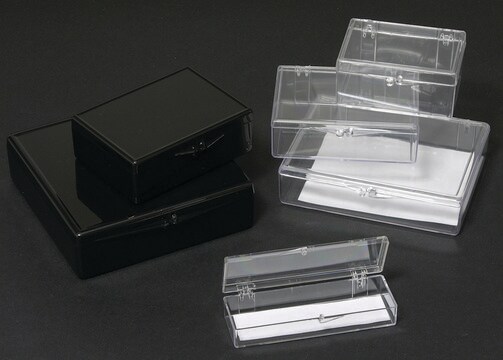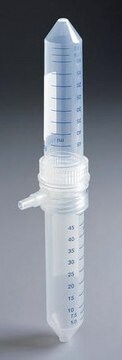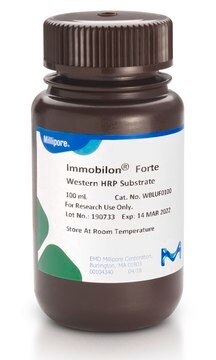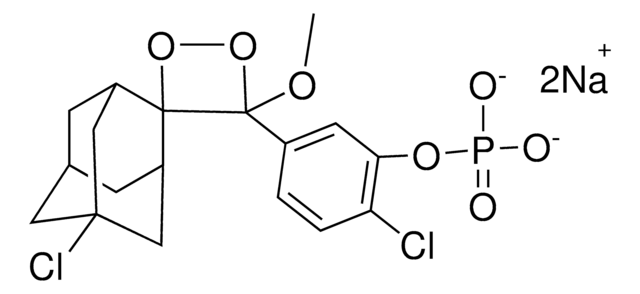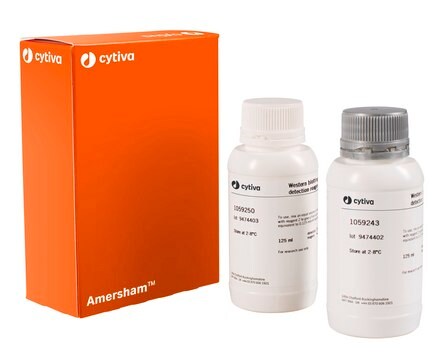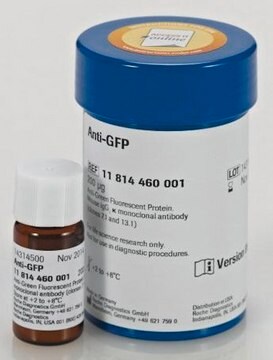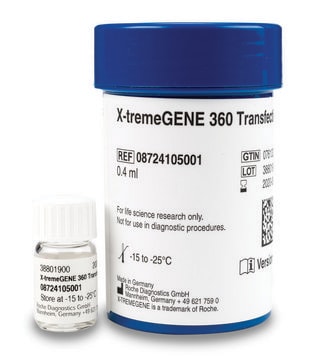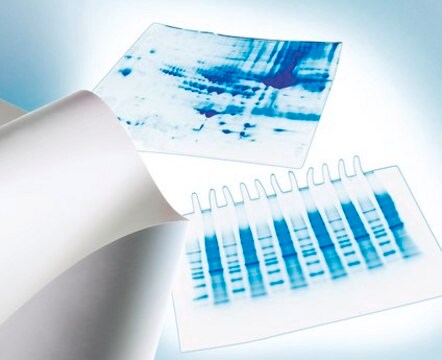12015196001
Roche
Lumi-LightPLUS Western Blotting Substrate
pkg of 100 mL (1,000 cm2 membrane)
Synonym(s):
western blotting substrate
Sign Into View Organizational & Contract Pricing
All Photos(2)
About This Item
UNSPSC Code:
12352204
Recommended Products
packaging
pkg of 100 mL (1,000 cm2 membrane)
Quality Level
manufacturer/tradename
Roche
shipped in
wet ice
storage temp.
2-8°C
General description
As the technology for quantifying chemiluminescence advances, the substrates for chemiluminescence must also advance. For instance, the light emission of conventional enhanced luminol substrates substantially decreases within 30 minutes. In contrast, the chemiluminescence signal of the Lumi-LightPLUS substrate persists for more than nine hours, and since exposures of only a few minutes are necessary, multiple exposures can be taken. Additionally, the ability to take extended exposures allows the detection of rare proteins, or higher dilutions of antigen or antibody to be used. The emission wavelength of the Lumi-LightPLUS substrate is 425 nm.
Comparison of Lumi-Light Substrate and Lumi-Light PLUS Substrate
Lumi-Light Substrate Lumi-LightPLUS Substrate
Sensitivity 10-50 pg antigen 1-5 pg antigen
Pimary Antibody Dilution Dilute up to 10-fold more compared to colorimetric detection Dilute up to 100-fold more compared to colorimetric detection
Signal Stability >3 hours (enhance signal with a 30-minute incubation) > 9 hours (enhance signal with a 30-minute incubation)
Number of tests: The reagent is sufficient for 10 blots, each with a size of 10 cm x 10 cm.
Sensitivity: Depending on the affinity of the primary antibody, 1 - 5 pg of antigen can be detected in research studies.
Storage/stability: The Lumi-LightPLUS substrate components are stable at +2 to +8°C until the expiration date printed on the label. Components are shipped at +15 to +25°C.
Comparison of Lumi-Light Substrate and Lumi-Light PLUS Substrate
Lumi-Light Substrate Lumi-LightPLUS Substrate
Sensitivity 10-50 pg antigen 1-5 pg antigen
Pimary Antibody Dilution Dilute up to 10-fold more compared to colorimetric detection Dilute up to 100-fold more compared to colorimetric detection
Signal Stability >3 hours (enhance signal with a 30-minute incubation) > 9 hours (enhance signal with a 30-minute incubation)
Number of tests: The reagent is sufficient for 10 blots, each with a size of 10 cm x 10 cm.
Sensitivity: Depending on the affinity of the primary antibody, 1 - 5 pg of antigen can be detected in research studies.
Storage/stability: The Lumi-LightPLUS substrate components are stable at +2 to +8°C until the expiration date printed on the label. Components are shipped at +15 to +25°C.
Application
Lumi-LightPLUS Western Blotting Substrate has been used in western blotting.
Lumi-LightPLUS Western Blotting Substrate is for the chemiluminescent detection of antigens blotted on membranes using horseradish peroxidase-conjugated secondary antibodies. It can be used for very sensitive detection of any antigen blotted on a PVDF Western Blotting Membrane or nitrocellulose membrane.
Lumi-LightPLUS Western Blotting Substrate is suited for high-sensitivity western blotting, especially when quantification is required. The chemiluminescent signal persists for more than 9 hours, allowing multiple exposures to be taken.
Lumi-LightPLUS Western Blotting Substrate is suited for high-sensitivity western blotting, especially when quantification is required. The chemiluminescent signal persists for more than 9 hours, allowing multiple exposures to be taken.
Features and Benefits
- Detect rare proteins. Detect antigen in the range of 1 - 5 pg.
- Take multiple exposures. The signal is stable for more than nine hours after substrate addition.
- Save sample material. Lumi-LightPLUS substrate detects less than 5 pg-amounts of antigen.
- Save valuable resources. Dilute primary antibody 10- to 100-fold more than with colorimetric detection systems.
- Benefit from easy preparation. Simply mix the two Lumi-Light components in a 1:1 ratio.
Packaging
1 kit containing 2 components
Quality
Each lot is function tested using mouse or rabbit primary antibodies.
Preparation Note
Stabilizers: proteinaceous stabilizers
Working concentration: The working concentration of conjugate depends on application and substrate.
The following concentrations should be taken as a guideline:
Working solution: Preparation of Additional Reagents and Solutions
The table inside the package insert describes the preparation of working solutions. Volumes are designed for a membrane of 10x10 cm. If larger membranes are used, volumes have to be scaled up. For reproducible results, equilibrate all solutions to room temperature before use.
Note: Do not use Azide to stabilize the solutions against microbial growth, as azide irreversibly inhibits horseradish peroxidase.
Working concentration: The working concentration of conjugate depends on application and substrate.
The following concentrations should be taken as a guideline:
- Dot blot: 50 mU/ml
- ELISA: 25 mU/ml
- Western blot: 50 mU/ml
Working solution: Preparation of Additional Reagents and Solutions
The table inside the package insert describes the preparation of working solutions. Volumes are designed for a membrane of 10x10 cm. If larger membranes are used, volumes have to be scaled up. For reproducible results, equilibrate all solutions to room temperature before use.
Note: Do not use Azide to stabilize the solutions against microbial growth, as azide irreversibly inhibits horseradish peroxidase.
Other Notes
For life science research only. Not for use in diagnostic procedures.
Kit Components Only
Product No.
Description
- Lumi-LightPLUS Luminol/Enhancer Solution
- Lumi-LightPLUS Stable Peroxide Solution
Storage Class Code
12 - Non Combustible Liquids
WGK
WGK 1
Flash Point(F)
does not flash
Flash Point(C)
does not flash
Choose from one of the most recent versions:
Already Own This Product?
Find documentation for the products that you have recently purchased in the Document Library.
Customers Also Viewed
Serum-Induced Differentiation of Glioblastoma Neurospheres Leads to Enhanced Migration/Invasion Capacity That Is Associated with Increased MMP9
Joseph JV, et al.
PLoS ONE (2015)
Hana Cernecka et al.
Naunyn-Schmiedeberg's archives of pharmacology, 385(9), 875-882 (2012-06-13)
β(3)-Adrenoceptors are a promising drug target for the treatment of urinary bladder dysfunction, but knowledge about their expression at the protein level and their functional role is limited, partly due to a lack of well validated tools. As many antibodies
Thioredoxin-1 protects against androgen receptor-induced redox vulnerability in castration-resistant prostate cancer
Samaranayake GJ, et al.
Nature Communications, 8(1), 1204-1204 (2017)
Ataxia telangiectasia mutated (ATM) inhibition transforms human mammary gland epithelial cells
Mandriota SJ, et al.
The Journal of Biological Chemistry, 285(17), 13092-13106 (2010)
Our team of scientists has experience in all areas of research including Life Science, Material Science, Chemical Synthesis, Chromatography, Analytical and many others.
Contact Technical Service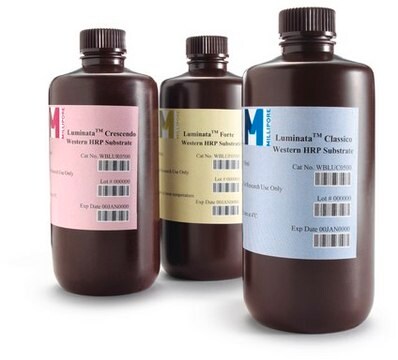
![BM Chemiluminescence Western Blotting Substrate (POD) pkg of 1 set (11500708001 [1,000 cm2 membrane]), pkg of 1 set (11500694001 [4,000 cm2 membrane])](/deepweb/assets/sigmaaldrich/product/images/352/091/ef743cea-ccd8-44f1-8f3b-dec5a1e4f5d1/640/ef743cea-ccd8-44f1-8f3b-dec5a1e4f5d1.jpg)
